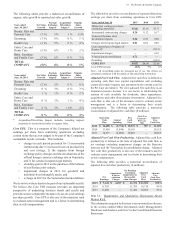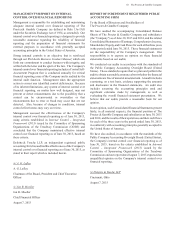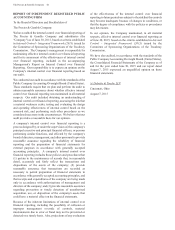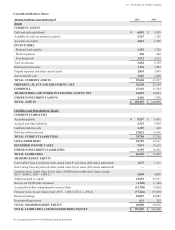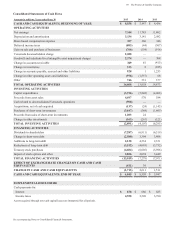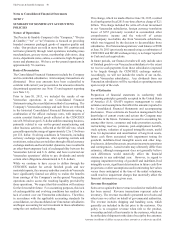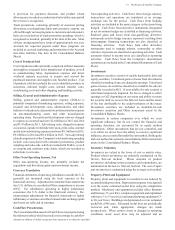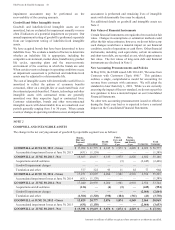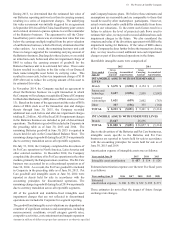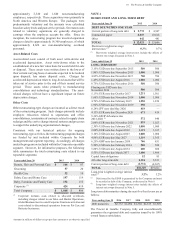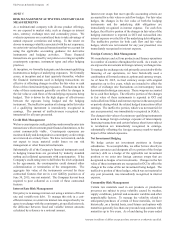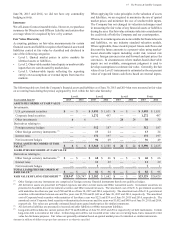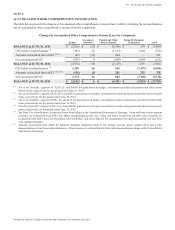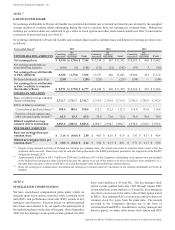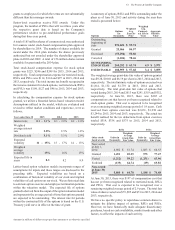Proctor and Gamble 2015 Annual Report Download - page 53
Download and view the complete annual report
Please find page 53 of the 2015 Proctor and Gamble annual report below. You can navigate through the pages in the report by either clicking on the pages listed below, or by using the keyword search tool below to find specific information within the annual report.51 The Procter & Gamble Company
Amounts in millions of dollars except per share amounts or as otherwise specified.
A provision for payment discounts and product return
allowances is recorded as a reduction of sales in the same period
the revenue is recognized.
Trade promotions, consisting primarily of customer pricing
allowances, merchandising funds and consumer coupons, are
offered through various programs to customers and consumers.
Sales are recorded net of trade promotion spending, which is
recognized as incurred, generally at the time of the sale. Most
of these arrangements have terms of approximately one year.
Accruals for expected payouts under these programs are
included as accrued marketing and promotion in the Accrued
and other liabilities line item in the Consolidated alance
Sheets.
Cost of Products Sold
Cost of products sold is primarily comprised of direct materials
and supplies consumed in the manufacture of product, as well
as manufacturing labor, depreciation expense and direct
overhead expense necessary to acquire and convert the
purchased materials and supplies into finished product. Cost
of products sold also includes the cost to distribute products to
customers, inbound freight costs, internal transfer costs,
warehousing costs and other shipping and handling activity.
Selling, General and Administratie Exense
Selling, general and administrative expense (SG&A) is
primarily comprised of marketing expenses, selling expenses,
research and development costs, administrative and other
indirect overhead costs, depreciation and amortization expense
on non-manufacturing assets and other miscellaneous
operating items. Research and development costs are charged
to expense as incurred and were $2.0 billion in 2015 and 2014
and $1.9 billion in 2013. Advertising costs, charged to expense
as incurred, include worldwide television, print, radio, internet
and in-store advertising expenses and were $8.3 billion in 2015,
$9.0 billion in 2014 and $9.4 billion in 2013. Non-advertising
related components of the Company's total marketing spending
include costs associated with consumer promotions, product
sampling and sales aids, which are included in SG&A, as well
as coupons and customer trade funds, which are recorded as
reductions to net sales.
Other Non-Oerating Income, Net
Other non-operating income, net, primarily includes net
acquisition and divestiture gains and investment income.
Currenc Translation
Financial statements of operating subsidiaries outside the U.S.
generally are measured using the local currency as the
functional currency. Adjustments to translate those statements
into U.S. dollars are recorded in Other comprehensive income
(OCI). For subsidiaries operating in highly inflationary
economies, the U.S. dollar is the functional currency. Re-
measurement adjustments for financial statements in highly
inflationary economies and other transactional exchange gains
and losses are reflected in earnings.
Cash Flow Presentation
The Consolidated Statements of Cash Flows are prepared using
the indirect method, which reconciles net earnings to cash flow
from operating activities. Cash flows from foreign currency
transactions and operations are translated at an average
exchange rate for the period. Cash flows from hedging
activities are included in the same category as the items being
hedged. Cash flows from derivative instruments designated
as net investment hedges are classified as financing activities.
Realized gains and losses from non-qualifying derivative
instruments used to hedge currency exposures resulting from
intercompany financing transactions are also classified as
financing activities. Cash flows from other derivative
instruments used to manage interest, commodity or other
currency exposures are classified as operating activities. Cash
payments related to income taxes are classified as operating
activities. Cash flows from the Company's discontinued
operations are included in the Consolidated Statements of Cash
Flows.
Inestments
Investment securities consist of readily marketable debt and
equity securities. Unrealized gains or losses from investments
classified as trading, if any, are charged to earnings. Unrealized
gains or losses on securities classified as available-for-sale are
generally recorded in OCI. If an available-for-sale security is
other than temporarily impaired, the loss is charged to either
earnings or OCI depending on our intent and ability to retain
the security until we recover the full cost basis and the extent
of the loss attributable to the creditworthiness of the issuer.
Investment securities are included as Available-for-sale
investment securities and Other noncurrent assets in the
Consolidated alance Sheets.
Investments in certain companies over which we exert
significant influence, but do not control the financial and
operating decisions, are accounted for as equity method
investments. Other investments that are not controlled, and
over which we do not have the ability to exercise significant
influence, are accounted for under the cost method. oth equity
and cost method investments are included as Other noncurrent
assets in the Consolidated alance Sheets.
Inentor Valuation
Inventories are valued at the lower of cost or market value.
Product-related inventories are primarily maintained on the
first-in, first-out method. Minor amounts of product
inventories, including certain cosmetics and commodities, are
maintained on the last-in, first-out method. The cost of spare
part inventories is maintained using the average-cost method.
Proert, Plant and Euiment
Property, plant and equipment is recorded at cost reduced by
accumulated depreciation. Depreciation expense is recognized
over the assets' estimated useful lives using the straight-line
method. Machinery and equipment includes office furniture
and fixtures (15-year life), computer equipment and capitalized
software (3- to 5-year lives) and manufacturing equipment (3-
to 20-year lives). uildings are depreciated over an estimated
useful life of 40 years. Estimated useful lives are periodically
reviewed and, when appropriate, changes are made
prospectively. hen certain events or changes in operating
conditions occur, asset lives may be adjusted and an


